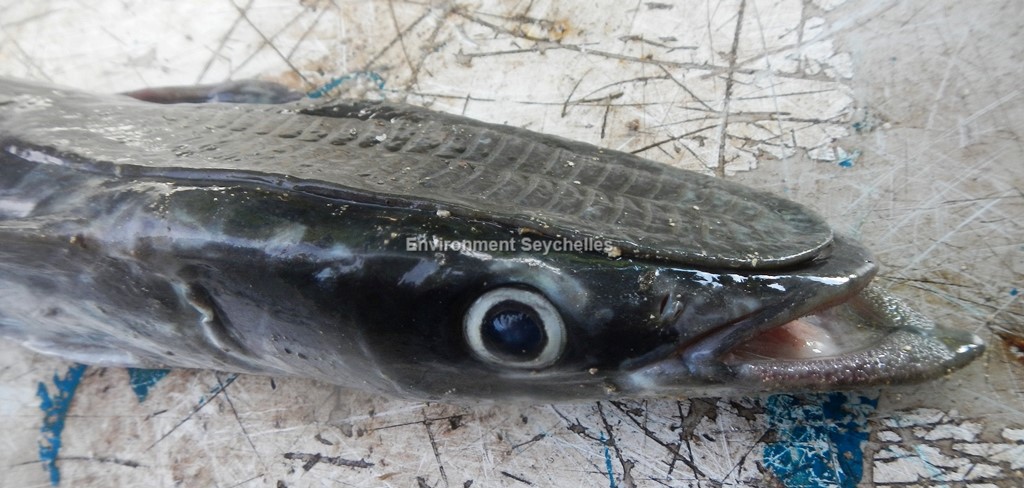Description:
Dorsal spines: 0; Dorsal rays: 32-42; Anal spines: 0; Anal rays: 29-41.
Elongate fish. Jaws broad, the lower projecting beyond the upper. Many small sharp villiform teeth in jaws, on tongue and on vomerine patches. First dorsal fin replaced by
a transversal, laminated, oval cephalic disc, with 16 to 28 laminae, positioned from the top of the head to the anterior portion of the body. Second dorsal fin and anal fin
originate at the midlength of the body and taper, extending almost to the base of the caudal fin. Pectoral fins short, pointed and high on body. Caudal fin forked with long
central filament in young, truncate to forked in adults.
Colour. Dark grey‑brown to black above, paler below with dark, often pale-edged midlateral stripe. Fins dark to black in adults. Juveniles with upper and lower margins of
fins white.
Size:
Maturity: Lm unknown. Range unknown. Max Length: 110cm TL, commonly to 66cm SL.
Habitat and Ecology:
Occurs near as well as far from the coast. Often found free-swimming in shallow inshore areas and around coral reefs (depth 1-85m). Attaches temporarily to a variety of
hosts including sharks, rays, large bony fishes or sea turtles, whales, dolphins and also to ships.
Its diet consists of small fishes, its host's parasites, and scraps from its host's prey. Juveniles will occasionally clean fishes at reef cleaning stations.
Fishery Status:
This species is not protected or subject to fishery regulations. It is rarely landed by the artisanal fishery.
Notes:
References:
Bester, C. (2017). Echeneis naucrates. https://www.floridamuseum.ufl.edu/discover-fish/species-profiles/echeneis-naucrates/ (08/05/20).
Bray, D.J. & Gomon, M.F. Echeneis naucrates in Fishes of Australia, http://136.154.202.208/home/species/3711 (08/05/20).
Collette, B. et al. (2015). Echeneis naucrates (errata version 2017). The IUCN Red List 2015: https://dx.doi.org/10.2305/IUCN.UK.2015-4.RLTS.T190393A15603110.en. (08/05/20).
Fischer, W. & G. Bianchi (eds), (1984). FAO species identification sheets for fishery purposes. Western Indian Ocean; (Fishing Area 51). Prepared and printed with the
support of the Danish International Development Agency (DANIDA). Rome, Food and Agricultural Organization of the United Nations, vols 1-6.
Froese, R. & D. Pauly. (Eds.) (2020). FishBase. https://www.fishbase.se/summary/Echeneis-naucrates.html (08/05/20).
Citation:
Nevill, J.E.G. (2020). Echeneis naucrates, Live sharksucker. Seychelles Seatizens. www.seatizens.sc. https://seatizens.sc/species/echeneis-naucrates-linnaeus-1758/ (edited 03/07/22).




Great work! This is the type of information that should be
shared across the web. Shame on the seek engines for no longer positioning
this publish higher! Come on over and discuss with my website .
Thanks =) https://tonybetca.Wordpress.com/
It’s amazing in support of me to have a website,
which is good designed for my know-how. thanks admin
At this time I am ready to do my breakfast, afterward having my breakfast coming again to read other news.
Genuinely appreciated going through this article. It’s highly well-written and packed with helpful information. Thanks for offering this.